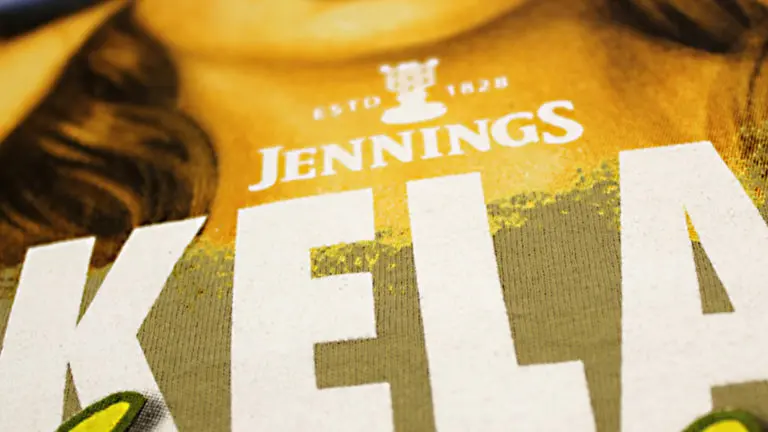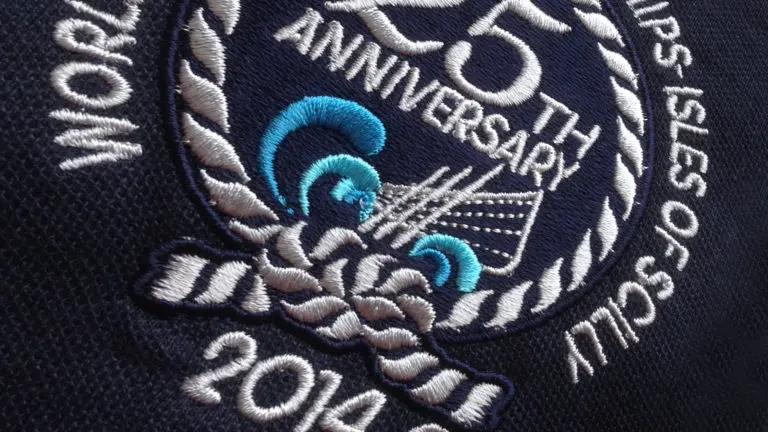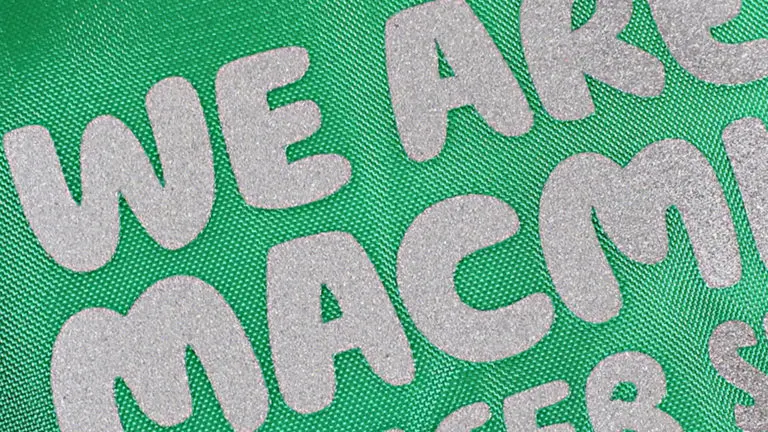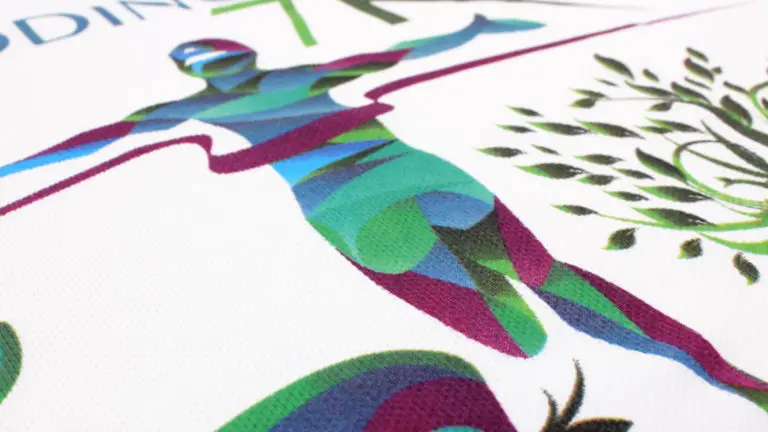John Roberts Associates provides custom-branded clothing & sportswear for all types of sectors. From Workwear to cycling jerseys, we provide it all. Not only that, each item can be custom branded to your company logo, cycling club colours or unique event styles.
Our clothing can be customised using a variety of print processes. This page discusses the various processes we can offer.

Screen Printing
Screen printing, also known as silk screening, is a versatile and widely-used method of printing that involves pushing ink through a fine mesh or screen onto a substrate, such as fabric or paper. This technique is commonly employed for printing graphics, logos, and images on various surfaces, with a primary focus on textiles, apparel, and promotional items. Let’s delve deeper into the process and its characteristics:
Printing Process
Screen printing is a manual or automated process that involves multiple steps:
- Design Preparation: The first step is to create or prepare the design to be printed. This design is then transferred onto a transparent film, with each colour represented as a separate layer.
- Screen Preparation: A mesh screen, typically made of polyester or stainless steel, is stretched tightly onto a frame. The screen is then coated with a light-sensitive emulsion, and the film with the design is placed on top of the screen. Exposing the screen to UV light hardens the emulsion, leaving the design as an open area on the screen.
- Printing: The screen is placed on the substrate (e.g., a T-shirt), and ink is applied on top of it. A squeegee is used to force the ink through the mesh, transferring the design onto the material. Each colour in the design requires a separate screen and printing pass.
- Drying and Curing: After each colour is printed, the ink is dried or cured using heat or UV light to ensure it adheres permanently to the substrate.
Colour Layering
One of the unique aspects of screen printing is the ability to layer colours. Each colour is applied individually, allowing for intricate and multi-colour designs. This layering process results in vibrant and highly detailed images.
Durability
Screen printing is renowned for its durability. The inks used in screen printing are typically thick and can withstand repeated washing and wear without fading or peeling. This makes it an excellent choice for custom apparel, team uniforms, and promotional items that need to maintain their appearance over time.
Versatility
While it is most commonly associated with textiles, screen printing can also be used on a variety of surfaces, including paper, plastic, metal, and wood. It’s a versatile technique that adapts well to different materials and applications.
Popularity
Screen printing remains a popular choice for custom clothing, merchandise, and promotional products due to its ability to produce high-quality, long-lasting prints. It is favoured by businesses, artists, and individuals looking to create custom, eye-catching designs.
In summary, screen printing is a time-tested and versatile printing method known for its durability, vibrant colours, and ability to create intricate designs on various surfaces. Whether you’re looking to print T-shirts, posters, or promotional items, screen printing offers a reliable and visually appealing solution.

Embroidery
Embroidery is a meticulous and enduring process that takes textile decoration to a whole new level. It involves the artful use of various coloured threads, meticulously stitched into the fabric, creating a stunning and permanent pattern that can truly transform any piece of clothing. This method offers a distinctive touch to garments, whether it’s for fashion, workwear, or promotional purposes.
The Craft of Embroidery
In the world of textile embellishment, embroidery stands out as a true craftsmanship. Skilled artisans and advanced machinery work in harmony to bring your designs to life. Each stitch is carefully placed, ensuring precision and attention to detail. This meticulous approach not only adds aesthetic value but also enhances the overall durability of the garment.
Versatility in Garment Decoration
Embroidery’s versatility knows no bounds. It can be applied directly to garments or crafted as a separate badge, which can later be sewn onto the fabric. This flexibility allows for creativity and customization, making it a popular choice for a wide array of apparel, from elegant dress shirts to practical workwear.
Longevity and Endurance
One of the most notable features of embroidery is its longevity. Unlike some other decoration methods that may fade or peel over time, embroidery stands the test of time. The threads are securely integrated into the fabric, ensuring that your design remains vibrant and intact for years to come.
Ideal for Various Garments
Embroidery’s adaptability extends to various types of garments. It finds a natural home on professional workwear, lending an air of sophistication and branding to uniforms. For casual wear, such as polo shirts and sweatshirts, embroidery adds a touch of personalization and style. Even jackets can benefit from this exquisite technique, making them stand out in any setting.
In conclusion, embroidery is not merely a method of decorating garments; it’s a form of artistry that infuses personality, durability, and charm into every piece. Whether you seek to make a fashion statement or brand your work attire, embroidery remains an exceptional choice that leaves a lasting impression.

Transfers
Transfers are a versatile method for applying artwork to garments, and they rely on the application of heat to effectively “glue” the design onto the fabric. This heat-transfer process offers a multitude of creative possibilities, with the flexibility to choose from a diverse palette of colors and finishes. These options encompass a range of styles, from the understated elegance of matte to the eye-catching allure of metallic, fluorescent, and glitter finishes.
At our facility, we specialize in crafting custom transfers that cater to your specific needs. Whether you require your company’s logo, a specific text, or intricate images, we have the expertise to transform your ideas into high-quality transfers. This customization capability makes transfers an ideal choice for a variety of applications, including sportswear, workwear, running vests, and hi-visibility garments.
Our commitment to quality ensures that your transferred designs not only look great but also stand the test of time, even in the face of the most demanding conditions. With transfers, you can achieve a durable and visually stunning result that reflects your unique style and brand identity.

Sublimation
Sublimation printing is undeniably one of the most versatile and durable methods in our arsenal of printing techniques. What truly sets it apart is its ability to produce images that are not just vibrant but also permanent, standing the test of time without any hint of peeling or fading. This makes it a preferred choice for preserving photographic images on a wide array of surfaces.
In the world of contemporary technical fabrics, where innovation meets performance, sublimation printing finds its perfect niche. Take, for example, our Max Athlete running vests and our Max Velo cycling clothing. These garments, engineered with cutting-edge materials and design, are ideal canvases for the sublimation process.
One of the standout features of sublimation printing is its capacity to transform a plain white base garment or item into a canvas of endless possibilities. This attribute bestows upon sublimation one of its most significant advantages – the ability to match the garment and design with pinpoint accuracy to your corporate colors. Whether your brand’s palette is a bold and striking crimson or a tranquil and serene azure, sublimation printing can bring it to life on your chosen fabric.
Sublimation printing, with its combination of longevity, versatility, and color-matching precision, truly stands as a hallmark in the world of apparel customization. It not only ensures that your designs leave a lasting impression but also guarantees that your brand’s identity remains vivid and intact throughout the life of the garment.
